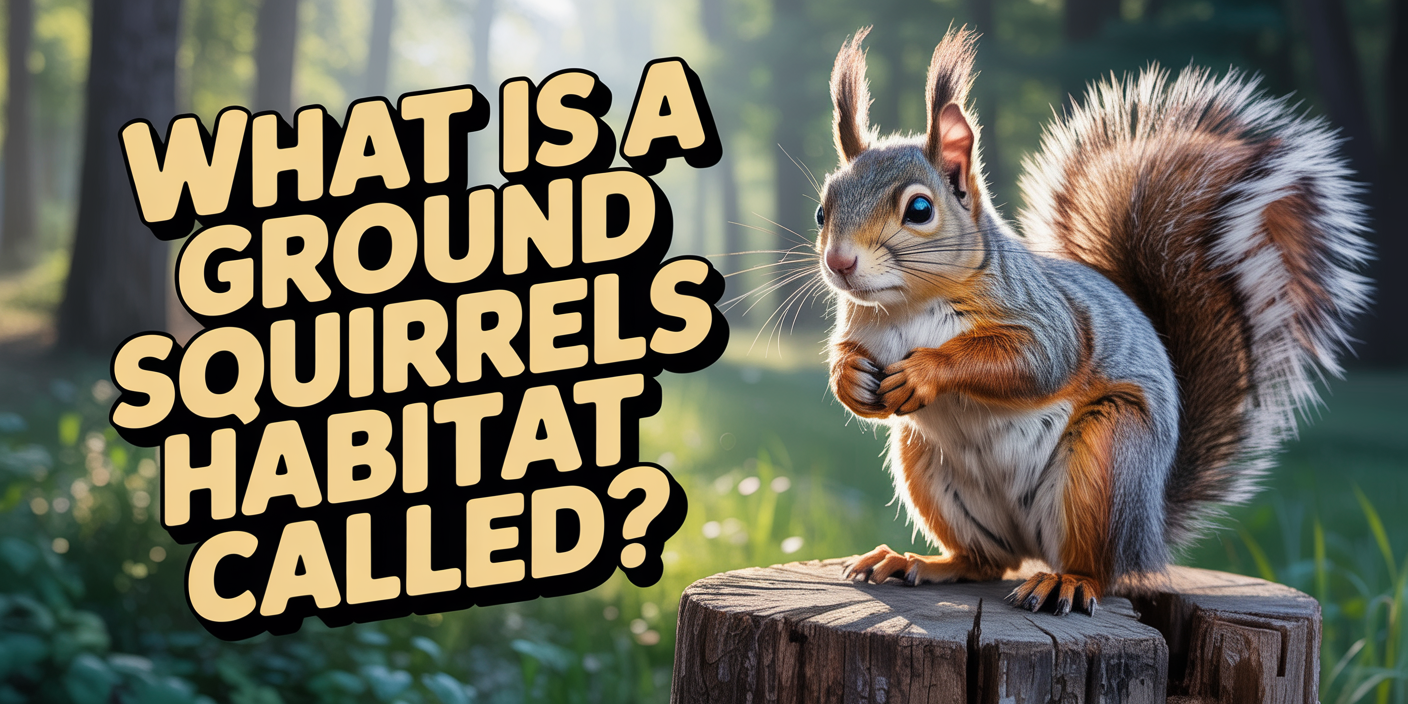A ground squirrel’s habitat is called a burrow, which is an underground tunnel system they dig for shelter, nesting, and food storage. These burrows protect them from predators, harsh weather, and give them space to raise their young.
Ground squirrels are expert diggers known for creating elaborate underground homes that often go unnoticed—until you see the mounds in your yard. These animals aren’t just casual burrowers; they build complex tunnel systems that serve as their primary habitat.
Understanding what their habitat is called and how it functions can help you recognize the signs early and take proper action. Whether you’re dealing with a few holes or a full-blown colony, knowing their environment is the first step toward managing them safely and effectively.
What Is a Ground Squirrel’s Habitat Called?
A ground squirrel’s habitat is called a burrow, which is an underground network of tunnels and chambers they dig out using their sharp claws. These burrows are essential for their survival, offering protection from predators, extreme temperatures, and threats from above ground.
Some people might refer to them as dens or tunnel systems, but “burrow” is the most accurate term. These structures aren’t random holes—they’re carefully engineered spaces with multiple entry points, nesting areas, food storage chambers, and emergency exits.
Structure and Features of a Ground Squirrel Burrow
Entrance Holes and Escape Routes
Most burrows have several entrance and exit holes, each about 3 to 5 inches wide. These holes are often spread across open areas like yards, fields, or gardens and may be accompanied by small dirt mounds or scattered soil.
Escape routes are critical for evading predators like snakes, hawks, or coyotes. Ground squirrels will often bolt into one hole and reappear from another to confuse threats, showing just how strategic their tunnel design really is.
Nesting Chambers
Deep inside the burrow is the nesting chamber, where squirrels sleep, raise their young, and stay warm during colder days. These chambers are typically insulated with dry grass, leaves, and other soft materials squirrels collect from nearby areas.
Because they’re located further underground, nesting areas are more stable in terms of temperature and humidity. This makes them ideal spots for birthing pups and resting during extreme weather.
Food Storage Areas
Ground squirrels are known to cache food in side tunnels near the nesting chamber. These little storage zones are filled with seeds, nuts, and plant matter that can keep them fed during dry spells or when venturing outside becomes risky.
This food hoarding behavior helps them survive in unpredictable climates and also makes their burrows more than just shelter—they’re survival bunkers built for long-term use.
Tunnel Network Depth and Layout
Burrow systems can stretch up to 30 feet long and several feet deep depending on the species and soil type. The main tunnel is usually about 4 to 6 inches in diameter and leads to multiple offshoots that serve various functions.
Some colonies even connect their burrows to those of neighboring ground squirrels, creating a shared habitat network. These communal setups increase the chance of survival but also expand the impact they have on lawns, crops, and landscaping.
Typical Environments Where Ground Squirrels Build Burrows
Grasslands and Open Fields
Open grassy areas are ideal for ground squirrels because they provide excellent visibility to watch for predators. These environments also offer loose, dry soil that’s easy to excavate and an abundance of natural food sources like seeds and vegetation.
Ground squirrels often create colonies in these open zones, with dozens of interconnected burrows stretching across wide areas. These colonies can become a serious issue for ranchers and landowners when left unmanaged.
Residential Yards and Gardens
Yards, flower beds, and gardens are especially attractive to ground squirrels due to easy food access and disturbed soil. They’ll dig burrows along fences, under decks, or beside patios where shelter and cover are plentiful.
These burrows can weaken landscaping, damage irrigation systems, and even cause foundation issues if tunnels extend under structures. Homeowners may first notice the issue when plants are mysteriously disappearing or holes begin forming near concrete slabs.
Agricultural Land
Farms and orchards provide an endless buffet for hungry ground squirrels. They’ll burrow near crops, irrigation ditches, and barn foundations, where they can feed and reproduce with little disruption.
Over time, their tunneling can cause major structural damage to embankments and crop fields. Some farmers lose thousands of dollars annually due to crop destruction and soil instability caused by squirrel colonies.
Desert and Dry Regions
Certain species, like the California ground squirrel, have adapted to dry climates by building deeper and more insulated burrows. These structures help them manage temperature extremes and survive long periods without surface water.
In desert areas, you’ll often find burrows at the base of shrubs or under rocks where some moisture and shade are available. These ground squirrels time their activity to avoid peak heat and rely heavily on their underground shelters for survival.
Why Ground Squirrel Burrows Can Be a Problem
At first glance, a few small holes in the yard might not seem like a big deal. However, those openings are just the tip of a much larger underground network that can quietly cause extensive damage to your property over time.
Burrows can undermine sidewalks, patios, and even building foundations, leading to costly repairs and structural instability. On farms or ranches, they disrupt soil integrity, damage irrigation systems, and create hazardous holes for livestock to step into. Left unchecked, a single burrow can turn into a sprawling colony that’s difficult to manage without professional help.
Signs You Might Have Ground Squirrels on Your Property
One of the first signs is the appearance of small, round holes in your yard or garden, often surrounded by scattered soil or dirt mounds. These entry points are usually 3 to 5 inches wide and may seem randomly placed until you realize they’re part of a hidden tunnel system.
You might also notice ground squirrels darting around during the day, especially in the morning or late afternoon. Chewed garden plants, missing bulbs, or gnawed sprinkler heads are other red flags. If these signs are consistent, chances are high that ground squirrels have moved in—and their burrow network is growing.
How AAAC Wildlife Removal Can Help
Dealing with ground squirrel burrows requires more than just filling in holes or setting traps. At AAAC Wildlife Removal, we provide a thorough inspection to identify active burrow sites, assess colony size, and determine the safest and most effective removal strategy for your property.
Our team uses humane exclusion methods, structural barriers, and eco-friendly deterrents to prevent future damage. We’ll also help you repair affected areas and offer expert advice on how to make your home or land less attractive to ground squirrels. With AAAC, you get long-term protection—not just a temporary fix.
Conclusion
Ground squirrel burrows may start small, but they can escalate quickly into a widespread problem if ignored. Acting early gives you the best chance to stop structural damage, prevent crop loss, and avoid costly repairs down the line.
By recognizing the signs and understanding the nature of their habitat, you can take control before the situation worsens. Whether it’s sealing entry points, installing barriers, or calling in professionals, timely action is the key to protecting your space from further destruction.




